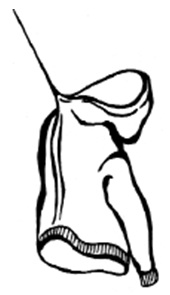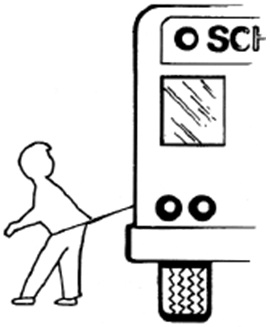The Commission has determined that hood and neck drawstrings on children's upper outerwear in sizes 2T to 12 or the equivalent present a strangulation hazard that is a substantial product hazard.
In addition, the Commission has determined that waist and bottom drawstrings on children's upper outerwear not meeting certain requirements also present a substantial product hazard. The length of drawstrings at the waist and bottom of children's upper outerwear in sizes 2T to 16 or the equivalent has been limited to 3 inches outside the drawstring channel when the garment is expanded to its fullest width; such garments must be free of toggles, knots, and other attachments at the free ends of drawstrings. If a waist or bottom drawstring in upper outerwear sizes 2T to 16 or the equivalent is one continuous string, it must be bar tacked (i.e., stitched through to prevent the drawstring from being pulled through its channel).
Young children can be seriously injured or killed if the upper outerwear they are wearing catches and snags on other objects. CPSC staff is aware of 26 deaths and 73 nonfatal incidents associated with neck/hood drawstrings on children’s outerwear between January 1985 and June 2019, involving children 18 months to 15 years of age. Of these, the most common incident scenarios involved drawstrings getting entangled on playground slides. Typically, as a child descended the slide, the toggle or knot on the drawstring got caught in a small space or gap at the top of the slide. Examples of catch points include a protruding bolt or a tiny space between the guardrail and the slide platform. This can present a strangulation risk and has resulted in death. Incidents have also occurred when the long, trailing drawstring at the waist of a jacket was caught on the closed door of a moving school bus.   |
- Classification of Drawstrings in Children's Upper Outerwear as a "Substantial Product Hazard": 16 CFR Part 1120
- Safety Standard on Drawstrings in Children's Upper Outerwear: ASTM F 1816-97
- Consumer Education: Drawstrings Not Allowed
Under voluntary standard ASTM F1816-97, drawstrings at the hood and neck area of children’s upper outerwear in sizes 2T to 12 (or the equivalent) are prohibited. In addition, the length of drawstrings at the waist and bottom of children’s upper outerwear in sizes 2T to 16 (or the equivalent) has been limited to 3 inches outside the drawstring channel when the garment is expanded to its fullest width; such garments must be free of toggles, knots, and other attachments at the free ends of drawstrings. If a waist or bottom drawstring in upper outerwear sizes 2T to 16 (or the equivalent) is one continuous string, it must be bar tacked (i.e., stitched through to prevent the drawstring from being pulled through its channel).
In general, the standard prohibits drawstrings at the hood and neck area of children's upper outerwear in sizes 2T to 12. In addition, it limits the length of drawstrings at the waist and bottom of children's upper outerwear in sizes 2T to 16 to 3 inches outside the drawstring channel when the garment is expanded to its fullest width. For waist and bottom drawstrings in upper outerwear sizes 2T to 16, the standard prohibits toggles, knots, and other attachments at the free ends of drawstrings. The standard further requires that if a waist or bottom drawstring in upper outerwear sizes 2T to 16 is one continuous string, it must be bar tacked (i.e., stitched through to prevent the drawstring from being pulled through its channel).
Young children can be seriously injured or killed if the upper outerwear they are wearing catches and snags on other objects. CPSC staff is aware of 18 deaths and 38 nonfatal incidents associated with neck/hood drawstrings on children's outerwear between January 1985 and September 2009, involving children 18 months to 10 years of age. Of these, the most common incident scenarios involved drawstrings getting entangled on playground slides. Typically, as a child descended the slide, the toggle or knot on the drawstring got caught in a small space or gap at the top of the slide. Examples of catch points include a protruding bolt or a tiny space between the guardrail and the slide platform. This can present a strangulation risk and has resulted in death. Incidents have also occurred when the long, trailing drawstring at the waist of a jacket was caught on the closed door of a moving school bus.
The standard defines "upper outerwear" as "clothing, such as jackets and sweatshirts, generally intended to be worn on the exterior of other garments." This definition excludes underwear and inner layers, but it includes lightweight outerwear that is appropriate for use in warmer climates. Pants, shorts, and skirts are not intended for the upper portion of the body and are excluded from the scope of the standard.
CPSC recommends that children's upper outerwear have alternative closures, such as snaps, buttons, Velcro, and elastic. Manufacturers and retailers should provide upper outerwear with these alternative closures, rather than drawstrings at the head and neck area as they have been determined by the Commission to present a substantial product hazard.
To facilitate determining which garments that are sized under a sizing system other than the numerical system (2T to 16) are equivalent to sizes 2T to 16, the rule provides that garments in girls' size Large (L) and boys' size Large (L) are equivalent to size 12. Garments in girls' size Extra-Large (XL) and boys' size Extra-Large (XL) are equivalent to size 16. Garments in girls' and boys' letter or word sizes smaller than sizes Large (L) or Extra-Large (XL), as applicable, are equivalent to correspondingly smaller numerical sizes. The fact that a garment is labeled as being larger than size Large (L) or size Extra-Large (XL), as applicable, does not necessarily mean that the item is not equivalent to a size in the range of 2T to 12, or in the range of 2T to 16. The Commission may use any other evidence that would tend to show that a garment is a size that is equivalent to sizes 2T to 16. This information is found in the regulation: Regulation 16 CFR 1120.3(b)(2)(i)
If a garment is labeled for a range of sizes, the garment will be considered subject to ASTM F 1816-97 if any size within the range is subject to ASTM F 1816-97.
No. Belts are not included in the voluntary standard or the Commission's 15(j) rule for drawstrings, and therefore, they are not listed as an identified substantial product hazard in all cases (see pictographs directly below for an example of a belt not covered by the voluntary standard). However, should the Commission determine that certain belt configurations or styles in children's upper outerwear present a substantial product hazard under section 15(a)(2) of the Consumer Product Safety Act (CPSA) , it would seek corrective action under section 15 of the CPSA or section 15 of the Federal Hazardous Substances Act (FHSA).
|
The standard defines a drawstring as "a non-retractable cord, ribbon, or tape of any material to pull together parts of upper outerwear to provide for closure." The standard exempts from its requirements, children's upper outerwear with fully retractable drawstrings. Although the standard does not define the terms "non-retractable" and "fully retractable," a cord, ribbon, or tape is non-retractable if it is not fully retractable. A cord, ribbon, or tape is fully retractable only if it has all of the following characteristics: it retracts automatically and completely its full length into the garment after the user adjusts it to any tightness and then releases it, without any user effort to retract it, leaving only a cord lock, knot, toggle, or other attachment at its end, flush against the outside of the garment. A cord that protrudes from the garment, and a non-protruding cord with a free-swinging toggle, for example, would not constitute fully retractable cords. Note, however, that there can be no cord locks, knots, toggles, or other attachments on waist or bottom drawstrings.
Children's upper outerwear is subject to surface coating requirements, lead content limits, testing and certification, and tracking label requirements. These requirements are discussed below:
Surface Coating Limit: Children's upper outerwear may not be painted with paint that contains more than 0.009 percent lead (e.g., snaps). (See 16 CFR Part 1303)
Lead Content Limit: Children's upper outerwear cannot contain greater than 100 ppm (0.01 percent) of total lead content in any accessible component part.
Testing and Certification: A 15(j) rule is not a consumer product safety rule and does not create a consumer product safety standard that triggers an independent testing or certification requirement under section 14(a) of the CPSA. However, children's upper outerwear, like all products that are designed or intended primarily for children 12 years of age or younger, must be tested by an accredited and CPSC-accepted third party conformity assessment body for compliance with any applicable children's product safety rules. Based on that testing, a domestic manufacturer (or importer) of children's upper outerwear must issue a certificate indicating that the product complies with those rules.
Tracking Labels: Children's upper outerwear must have a tracking label or other distinguishing permanent mark. The tracking label shall be a permanent distinguishing mark on the product and its packaging, to the extent practicable, and it must contain certain basic information, including the source of the product, the date of manufacture, and cohort information, such as a batch or run number.
Section 15(j) of the CPSA gives the Commission the authority to specify, by rule, for a consumer product or class of consumer products, characteristics whose presence or absence the Commission considers a "substantial product hazard" under 15(a)(2) of the CPSA. This type of rule will hereinafter be referred to as a "15(j) rule."
While a 15(j) rule does not establish a consumer product safety standard, placing a consumer product on this substantial product hazard list has certain consequences. A product that is or has a substantial product hazard is subject to the reporting requirements of section 15(b) of the CPSA. 15 U.S.C. 2064(b). A manufacturer who fails to report a substantial product hazard to the Commission is subject to civil penalties under section 20 of the CPSA and possibly is subject to criminal penalties under section 21 of the CPSA. 15 U.S.C. 2069, 2070. A product that is or contains a substantial product hazard is subject to corrective action under section 15(c) and (d) of the CPSA. 15 U.S.C. 2064(c), (d). Thus, the Commission can order the manufacturer, distributor, or retailer of the product to offer to repair or replace the product, or to refund the purchase price to the consumer. Finally, a product that is offered for import into the United States, and is or contains a substantial product hazard, must be refused admission into the United States under section 17(a) of the CPSA. 15 U.S.C. 2066(a).
The Commission issued a 15(j) rule with regard to drawstrings. See 16 CFR § 1120.3. The rule places on the substantial product hazard list, found at 16 CFR Part 1120, "[c]hildren's upper outerwear in sizes 2T to 16 or the equivalent, and having one or more drawstrings, that is subject to, but not in conformance with, the requirements of ASTM F 1816-97, Standard Safety Specification for Drawstrings on Children's Upper Outerwear" [16 CFR § 1120.3(b)(1)].

